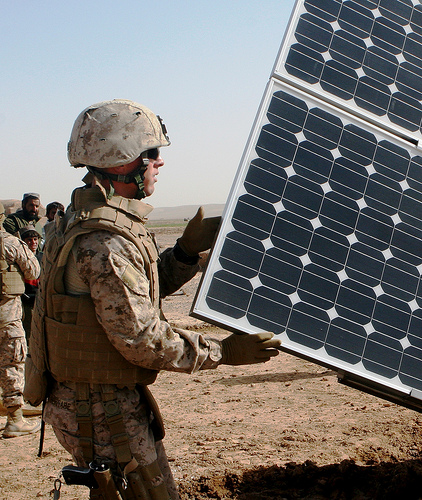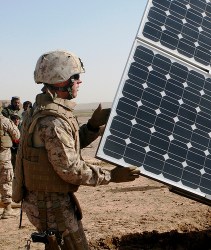This is my contribution to a dialogue on the military and clean energy being hosted by National Journal.
—
To understand the promise of renewable energy for the U.S. military, it helps to start as far from Washington, D.C., as possible. (This is true for most forms of understanding.) Start far from the politicians, even from the military brass, far from the rooms where big-money decisions are made, far out on the leading edge of the conflict, with a small company of Marines in Afghanistan’s Sangin River Valley.
Not long ago, for a three-day mission out of a forward operating base in Afghanistan, each Marine would have humped between 20 and 35 pounds of batteries. One of the reasons Marines are so lethal in such small numbers today is that they are constantly connected by radios and computers. But radios and computers require a constant supply of batteries, brought by convoy over some of the deadliest roads on earth and then piled on the backs of Marines in highly kinetic environments.
In late 2010, India Company, from the 3rd Battalion, 5th Marine Regiment, tried something new. They packed Solar Portable Alternative Communications Energy Systems, or SPACES — flexible solar panels, 64 square inches, that weigh about 2.5 pounds each. One 1st Lieutenant from India 3/5 later boasted that his patrol shed 700 pounds.
“We stayed out for three weeks,” he said, “and didn’t need a battery resupply once.”
This is a small example, of no great economic or geostrategic significance, yet it carries a profound lesson. It is a lesson that, in the unfolding age of energy insecurity, can be expressed as something like a universal law: reduced dependence on energy supply lines means greater autonomy, flexibility, and effectiveness.
The U.S. Marine Corps prides itself on being the U.S. military’s ship-to-shore expeditionary force — light, fast, and lethal, able to deploy quickly and operate autonomously in hostile or austere circumstances. So they have been the most sensitive to the chafing restrictions of what Gen. James Mattis, a Marine commander in the first Iraq war, famously called the “tether of fuel.”
That tether, the convoys crisscrossing Iraq and Afghanistan, not only slows the Marines and restricts their range of motion, it also gets them killed — one killed or wounded for each 50 convoys or so. And it is wildly expensive. By the time fuel is convoyed up through Pakistan or down through Russia, over the Hindu Kush mountains or across the Amu Darya river, and out from the big bases to the forward bases, sometimes on helicopter, fuel that costs the Marines $3 a gallon at the pump can reach a “fully burdened cost” of as high as $400 a gallon. It’s fair to say that Marines running diesel generators at forward operating bases in Afghanistan are using some of the most expensive fuel in the world.
With that in mind, Marines are field testing insulated tents, portable solar panels, LED lights, and systems to purify and cool local water. I reported on their efforts for a story in Outside last year, and every source I spoke to had the same thing to say: There may be some grumbling about the energy effort in the middle ranks, from officers set in their ways, but among young Marines on the front lines, and among the brass in the top ranks, there is nothing but enthusiasm.
It isn’t about “greening” anything or cooling the climate. “Other people are busy saving the planet; this is about saving Marine lives,” Col. Bob Charette, director of the Marine Corps Expeditionary Energy Office, said recently. “I’d kiss a polar bear if it meant getting one Marine off an IED-filled highway.”
Secretary of the Navy Ray Mabus has said that both the Navy and Marines will reduce fossil-fuel consumption by half by 2020. The Army and Air Force have also adopted aggressive goals. The military gets it: Reduced dependence on energy supply lines means greater autonomy, flexibility, and effectiveness. It’s not only true in the theater of war. It’s true for the great military fleets at sea and in the sky. It’s true for military bases in the U.S. or across the world, dependent on civilian power grids subject to attacks or blackouts.
And it’s not just true for the military. In a time of rising fossil-fuel prices and increasingly apparent climate dangers, the tether of fuel binds all of us — homes, businesses, communities, and whole economies — to a future of vulnerability and instability. Using less energy and generating more of our own is about more than dollars spent or saved. It’s about self-determination. That makes for a more effective military and a more secure, productive society.




